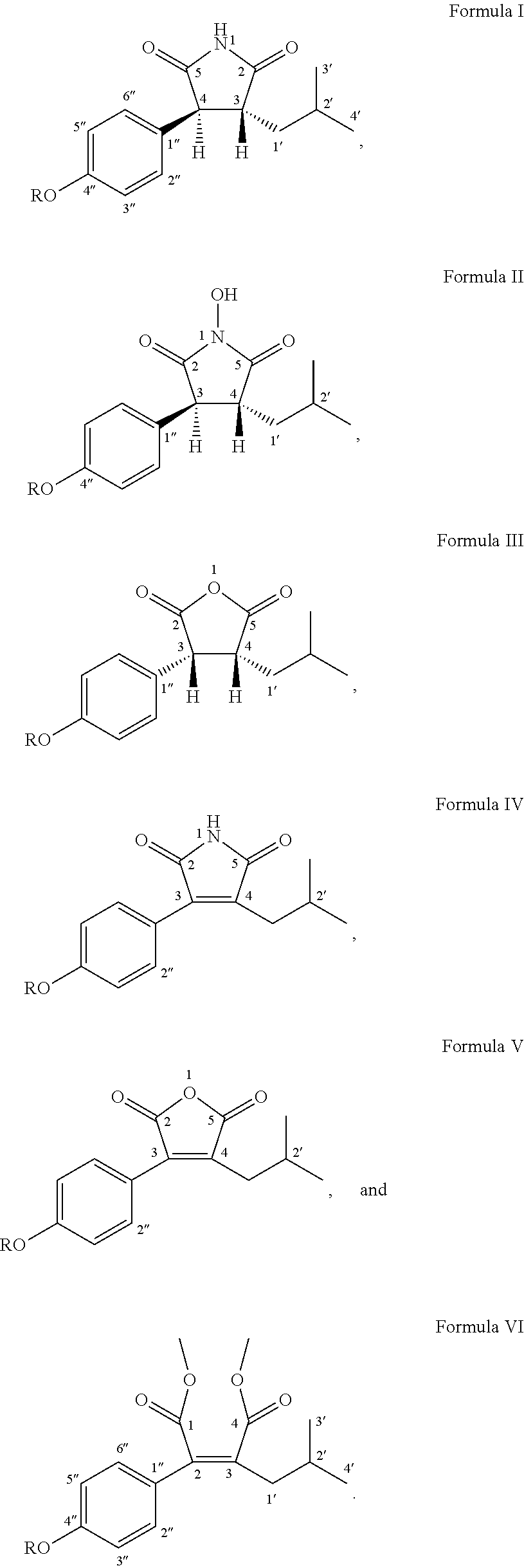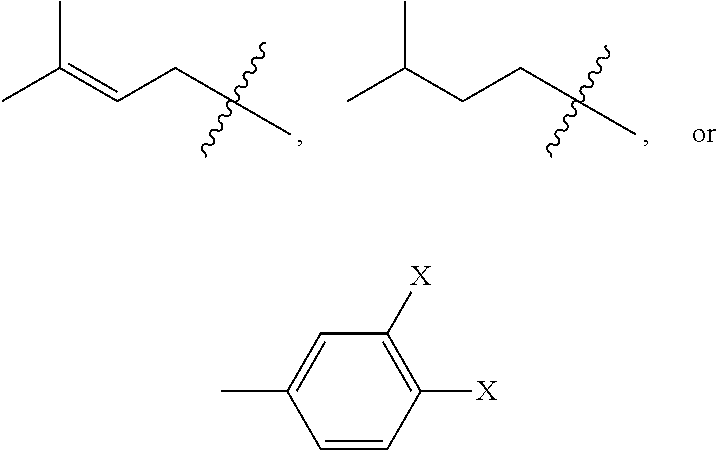Novel compounds from antrodia camphorata
a technology of which is applied in the field of new immunostimulatory and antiinflammatory compounds of antrodia camphorata, can solve problems such as difficult cultivation in the greenhouse, and achieve the effects of stimulating immune responses, stimulating immune responses, and stimulating immune responses
- Summary
- Abstract
- Description
- Claims
- Application Information
AI Technical Summary
Benefits of technology
Problems solved by technology
Method used
Image
Examples
example 1
Isolation and Characterization of Compounds
[0035]The fruiting bodies of solid culture A. camphorata (3.0 kg) were extracted with MeOH (12 L) by maceration at room temperature (4 days×3). After removal of MeOH in vacuum, H2O was added to bring the total volume to 1 L. This suspended phase was partitioned with EtOAc (1 L×3). Evaporation of the combined EtOAc layers afforded black syrup (212 g). The EtOAc fraction (200 g) was chromatographed on a silica gel column (10×70 cm, Merk 70-230 mesh) using n-hexane, EtOAc, and MeOH of increasing polarity as eluent to obtain 9 fractions: fr. 1 [8000 mL, n-hexane / EtOAc (19:1)], fr. 2 [7000 mL, n-hexane / EtOAc (9:1)], fr. 3 [6000 mL, n-hexane / EtOAc (8:2)], fr. 4 [10000 mL, n-hexane / EtOAc (7:3)], fr. 5 [8000 mL, n-hexane / EtOAc (1:1)], fr. 6 [9000 mL, n-hexane / EtOAc (1:3)], fr. 7 (8000 mL, EtOAc), fr. 8 [7000 mL, EtOAc / MeOH (1:0], fr. 9 (6000 mL, MeOH). A liquid-liquid partition was conducted to obtain the EtOAc fraction having anti-inflammatory act...
example 2
Immunostimulatory Effect of the Compounds
[0037]The cytokine levels in culture supernatants were measured by sandwich ELISA methods as described by Chen and Lin (Chen, M. L. et al., Int. Arch. Allergy Immunol. 2007, 143, 21-30). More specifically, the anti-cytokine antibodies (PharMingen, San Diego, Calif.) were coated in the 96-well plates (Nunc, Roskilde, Denmark) after overnight incubation at 4° C. and having been blocked with 1% BSA PBS buffer for 30 min. The samples and standards (recombinant mouse cytokines, PharMingen) were added to the 96-well plates for 2 hours incubation. The biotin-conjugated antibodies (biotinylated rat anti-mouse cytokine monoclonal antibodies, PharMingen) were added and incubated. After washing, streptavidin-conjugated peroxidase was added for 1 hour. The substrates, 2,2′-azino-bis-3-ethyl-benzthiazoline-6-sulfonic acid (ABTS, Sigma), were added to each well for 20 min. The plates were read in a microplate autoreader (Microplate autoreader; Bio-Tek Inst...
example 3
Anti-Inflammation Effect of the Compounds
[0040]IL-6, a proinflammatory cytokine which is a useful marker of infection, is secreted by macrophages in many infectious and inflammatory states, including cardiac surgery, cardiogenic shock, coronary bypass and bacteria sepsis (Kantar, M. et al., Eur. J. Pediatr. 2000, 159, 156-157). Serum concentration of IL-6 has been reported to correlate with disease severity (Pathan, N. et al., Lancet 2004, 363, 203-209). The productions of IL-6 from LPS-stimulated macrophages were measured to evaluate the anti-inflammation effect of the compounds. The cells were pretreated with compounds isolated from A. camphorata for 30 min and then stimulated with 50 ng / mL LPS for 48 hours. The supernatants were collected for TNF-α and IL-6 assay, and the cells were collected for viability analysis by MTT method. Data are showed as means±SD.
[0041]As shown in Table 4, these compounds did not affect the viability of RAW264.7 macrophages. When the cells were stimula...
PUM
| Property | Measurement | Unit |
|---|---|---|
| period of time | aaaaa | aaaaa |
| total volume | aaaaa | aaaaa |
| concentrations | aaaaa | aaaaa |
Abstract
Description
Claims
Application Information
 Login to View More
Login to View More - R&D
- Intellectual Property
- Life Sciences
- Materials
- Tech Scout
- Unparalleled Data Quality
- Higher Quality Content
- 60% Fewer Hallucinations
Browse by: Latest US Patents, China's latest patents, Technical Efficacy Thesaurus, Application Domain, Technology Topic, Popular Technical Reports.
© 2025 PatSnap. All rights reserved.Legal|Privacy policy|Modern Slavery Act Transparency Statement|Sitemap|About US| Contact US: help@patsnap.com


